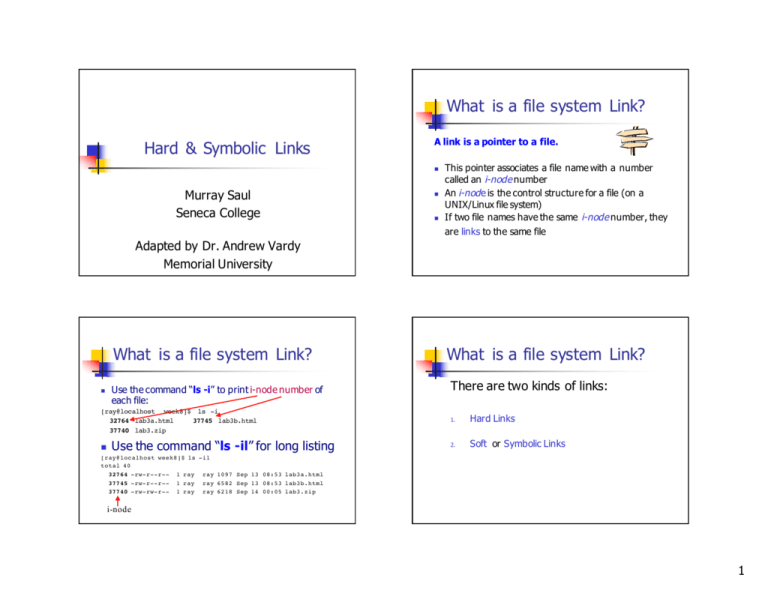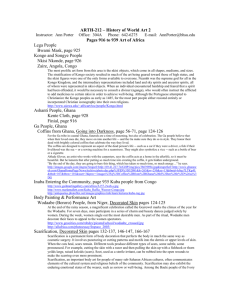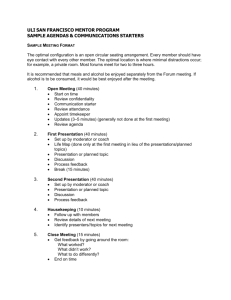Hard & Symbolic Links What is a file system Link? What is a file
advertisement

What is a file system Link? Hard & Symbolic Links A link is a pointer to a file. n Murray Saul Seneca College n n This pointer associates a file name with a number called an i-node number An i-nod e is the control structure for a file (on a UNIX/Linux file system) If two file names have the same i-node number, they are links to the same file Adapted by Dr. Andrew Vardy Memorial University What is a file system Link? n Use the command “ls -i” to print i-node number of each file: [ray@localhost week8]$ ls -i 32764 lab3a.html 37745 lab3b.html 37740 lab3.zip n Use the command “ls -il” for long listing What is a file system Link? There are two kinds of links: 1. Hard Links 2. Soft or Symbolic Links [ray@localhost week8]$ ls -il total 40 32764 -rw-r--r-- 1 ray ray 1097 Sep 13 08:53 lab3a.html 37745 -rw-r--r-- 1 ray ray 6582 Sep 13 08:53 lab3b.html 37740 -rw-rw-r-- 1 ray ray 6218 Sep 14 00:05 lab3.zip i-node 1 Hard Links n n n n n Hard link is a reference to the physical data on a file system All regular files are actually hard links More than one name can be associated with the same physical data Hard links can only refer to data that exists on the same file system You can not create hard link to a directory Display Hard Links info n n Hard Links Create a new file called “myfile” Run the command “ls -il” to display the i-node number and link counter 38753 -rw-rw-r-^ |-- inode # 1 uli uli 29 Oct 29 08:47 myfile ^ |-- link counter (one link) Example: n n Assume you used an editor to create a new file, you’ve just created the first hard link To Create the 2nd, 3rd and etc. hard links, use the command: n ln myfile link-name Display Hard Link Info n Create a 2nd link to the same data: ln myfile mylink n Run the command “ls -il”: 38753 -rw-rw-r-38753 -rw-rw-r-^ |-- inode # 2 uli uli 29 Oct 29 08:47 myfile 2 uli uli 29 Oct 29 08:47 mylink ^ |--link counter (2 links) 2 Add the 3rd Link n Removing a Hard Link Create a 3rd link to the same data: When a file has more than one link, you can remove any one link and still be able to access the file through the remaining links. ln myfile newlink n Run the command “ls -il”: 38753 -rw-rw-r-38753 -rw-rw-r-38753 -rw-rw-r-^ |-- inode # 3 uli 3 uli 3 uli ^ |--link uli uli uli 29 Oct 29 08:47 myfile 29 Oct 29 08:47 mylink 29 Oct 29 08:47 newlink counter (3 links) Symbolic Links Also Known As (a.k.a.): Soft links or Symlinks n n A Symbolic Link is an indirect pointer to a file – a pointer to the hard link to the file You can create a symbolic link to a directory n n A symbolic link can point to a file on a different file system n n Not so for hard links Symbolic Links n To create a symbolic link to the file “myfile”, use ln -s myfile symlink or ln --symbolic myfile symlink [uli@seneca courses] ls -li myfile 44418 -rw-rw-r-- 1 uli uli 49 Oct 29 14:33 myfile [uli@seneca courses] ln -s myfile symlink [uli@seneca courses] ls -li myfile symlink 44418 -rw-rw-r-- 1 uli uli 49 Oct 29 14:33 myfile 44410 lrwxrwxrwx 1 uli uli 6 Oct 29 14:33 symlink -> myfile Not so for hard links A symbolic link can point to a nonexistent file (referred to as a “broken link”) Different i-node File type: (symbolic link) Link counter: (1 link) 3 Properties of Symbolic Links n n n n n The i-node number is different from the pointed to file The link counter of the new symbolic link file is “1” Symbolic link file does not affect the link counter of the pointed to file The type field of symblic file contains the letter “l” The symbolic link file and the pointed to file have different status information (e.g. file size, last modification time etc.) Directory Listing n n Create Symbolic Link Directory n The syntax is the same as linking to a file ln -s target_directory link_directory ln --symbolic target_directory link_directory [uli@seneca week8]$ ls -li 38766 drwxrwxr-x 7 uli uli 168 Oct 29 13:32 courses [uli@seneca week8]$ ln courses mydir ln: `courses': hard link not allowed for directory [uli@seneca week8]$ ln -s courses mydir [uli@seneca week8]$ ls -li 38766 drwxrwxr-x 7 uli uli 168 Oct 29 13:32 courses 44417 lrwxrwxrwx 1 uli uli 7 Oct 29 15:41 mydir -> courses Delete link to a directory To display the contents in a directory, we normally use the command “ls -l directory_name” Compare the following two commands To delete a link to a directory, simply use the “rm” command: [uli@seneca lrwxrwxrwx week8]$ ls -l mydir 1 uli uli 7 Oct 29 15:41 mydir -> courses [uli@seneca week8]$ ls -l drwxrwxr-x 7 uli uli 168 Oct 29 13:32 courses lrwxrwxrwx 1 uli uli 7 Oct 29 15:41 mydir -> courses [uli@seneca drwxrwxr-x drwxrwxr-x drwxrwxr-x drwxrwxr-x week8]$ ls -l courses 2 uli uli 72 Oct 29 2 uli uli 72 Oct 29 2 uli uli 120 Oct 29 2 uli uli 72 Oct 29 [uli@seneca week8]$ rm mydir [uli@seneca week8]$ ls -l drwxrwxr-x 7 uli uli 168 Oct 29 13:32 courses 11:15 11:16 11:20 11:14 ica101 ios110 to_do uli101 4 Properties of Symbolic Link Directory n n n n The Symbolic link to a directory has a file type of “l” (the first letter of the permission field). The permissions on the link are set to “rwx” for all. The chmod command applied on the link applies to the actual directory (or file), the permissions on the link stay the same Can point to a nonexistent directory Drawbacks ofSymbolic Links n n n Iftheoriginalfileismovedtoadifferent location,itcannolongerbeaccessed via thesymboliclink(danglinglink) Extraspaceondiskandextrainodetostore thelinkfile(minimal) Extratimerequiredforaccesstothe originalfile:thelinkfilehastobereadfirst, thenpathfollowedtotargetfile(minimal) 5








